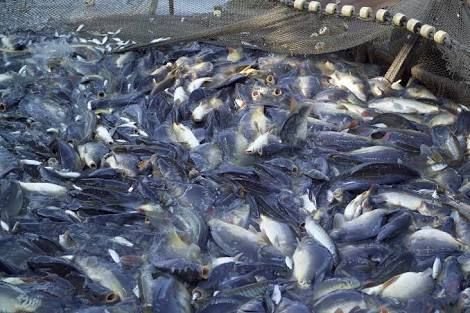Sustainable Investment in Fisheries,Our oceans are teeming with life, but unsustainable fishing practices threaten the delicate balance of marine ecosystems. This has significant consequences, not just for the environment, but also for the long-term viability of the fishing industry itself.
Sustainable investment in fisheries offers a promising solution. It allows investors to support practices that ensure healthy fish populations while generating financial returns. This approach benefits not only the environment but also fishing communities and consumers who rely on a steady supply of seafood.
Why is Sustainable Investment in Fisheries Important?
Sustainable Investment in Fisheries,The global demand for seafood is rising steadily, driven by population growth and increasing affluence. However, many traditional fishing practices are exceeding the capacity of fish populations to replenish themselves. This overfishing leads to:
- Depleted fish stocks: When fish are caught faster than they can reproduce, populations dwindle, leading to potential collapse of fisheries.
- Disrupted marine ecosystems: Overfishing can have a domino effect, impacting other marine life that depend on fish for food or compete for resources.
- Economic instability: Unsustainable fishing practices threaten the long-term viability of the fishing industry, jeopardizing jobs and livelihoods in coastal communities.
Sustainable Investment in Fisheries aims to address these challenges by promoting practices that ensure healthy fish populations and a healthy ocean.
Contents
Key Principles of Sustainable Fisheries Investment
Several key principles guide Sustainable Investment in Fisheries:
- Science-based quotas: Setting catch limits based on scientific assessments of fish population health is crucial. This ensures that fishing pressure remains within sustainable levels.
- Selective fishing gear: Minimizing bycatch, the unintentional capture of unwanted species, is important. Techniques like gear modifications and responsible fishing practices can significantly reduce bycatch.
- Habitat conservation: Protecting and restoring marine habitats where fish spawn and grow is essential for healthy fish populations.
- Community engagement: Collaboration with fishing communities is vital to ensure the long-term success of sustainable fisheries management.
Benefits of Sustainable Sustainable Investment in Fisheries
Sustainable Investment in Fisheries offers a range of benefits:
- Environmental benefits: Healthy fish populations and thriving marine ecosystems contribute to a healthy planet. Sustainable practices can help mitigate climate change by maintaining healthy ocean carbon sinks.
- Economic benefits: Sustainable fisheries provide a stable and reliable source of income for fishing communities and contribute to the overall health of the seafood industry.
- Social benefits: Sustainable fisheries support coastal communities and contribute to food security by providing a healthy and accessible source of protein.
- Investment returns: Sustainable fisheries can be financially profitable. As fish populations recover, catches become more stable, and the long-term value of the fishery increases. Investors who support sustainable practices are more likely to see positive returns on their investments.
Examples of Sustainable Fisheries Investment
There are various ways to Sustainable Investment in Fisheries:
- Investing in companies with strong sustainability practices: Look for companies committed to sourcing seafood from sustainable fisheries and implementing responsible fishing practices throughout their supply chain.
- Investing in fisheries improvement projects: These projects support fisheries transitioning to sustainable practices by providing resources for gear upgrades, training, and data collection.
- Investing in aquaculture: When done responsibly, aquaculture, or fish farming, can offer an alternative to wild-caught seafood, reducing pressure on wild fish populations. However, sustainable aquaculture practices are crucial, such as using alternative feed sources that don’t rely on wild fish.
Challenges and Opportunities
Sustainable fisheries investment faces challenges:
- Lack of data: In some regions, there’s a lack of reliable data on fish populations, making it difficult to set sustainable catch limits.
- Enforcement challenges: Effective enforcement of regulations is critical for ensuring sustainable practices are followed.
- Consumer awareness: Consumers need to be aware of the importance of sustainable seafood and make informed choices.
Despite these challenges, there are significant opportunities for sustainable fisheries investment:
- Growing consumer demand: Consumers are increasingly interested in sustainable seafood, creating a market for products that meet these criteria.
- Technological advancements: Advancements in data collection, fisheries monitoring, and gear technology can support sustainable practices.
- Collaboration: Collaboration between investors, governments, fishing communities, and NGOs can drive positive change.
The Future of Sustainable Fisheries Investment
Sustainable fisheries investment represents a powerful tool for ensuring the health of our oceans and the viability of the fishing industry. By aligning financial returns with environmental well-being, this approach offers a path towards a more sustainable future for our oceans and the seafood we rely on.
There are several ways to get involved in sustainable fisheries investment:
- Invest in companies: Research companies with strong sustainability practices in their seafood sourcing.
- Support NGOs: Support organizations working to promote sustainable fisheries practices.
- Make informed choices: Choose seafood certified by organizations like the Marine Stewardship Council (MSC), which recognizes well-managed and sustainable fisheries.


